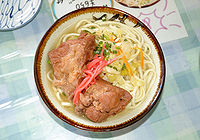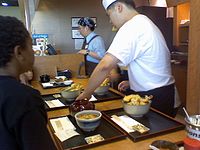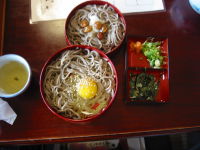- Soba
-
For other uses, see Soba (disambiguation).
 Soba served on a zaru
Soba served on a zaru
 Cutting of soba as part of its preparation at the Kanda Matsuri
Cutting of soba as part of its preparation at the Kanda Matsuri
Soba (そば or 蕎麦) is the Japanese name for buckwheat. It is synonymous with a type of thin noodle made from buckwheat flour, and in Japan can refer to any thin noodle (in contrast to thick wheat noodles, known as udon). Soba noodles are served either chilled with a dipping sauce, or in hot broth as a noodle soup. It takes three months for buckwheat to be ready for harvest, so it can be harvested four times a year, mainly in spring, summer, and autumn. In Japan, buckwheat is produced mainly in Hokkaido.[1] Soba that is made with newly-harvested buckwheat is called "shin-soba". It is sweeter and more flavorful than regular soba.
In Japan, soba noodles are served in a variety of settings: they are a popular inexpensive fast food at train stations[2] throughout Japan, but are also served by exclusive and expensive specialty restaurants. Markets sell dried noodles[3] and men-tsuyu, or instant noodle broth, to make home preparation easy.
Some establishments, especially cheaper and more casual ones, may serve both soba and udon as they are often served in a similar manner. However, soba is traditionally the noodle of choice for Tokyoites.[4] This tradition originates from the Tokugawa period, when the population of Edo (Tokyo), being considerably wealthier than the rural poor, were more susceptible to beri beri due to their high consumption of white rice, which is low in thiamine.[5] It was discovered that beri beri could be prevented by regularly eating thiamine-rich soba.[6] In the Tokugawa era, every neighborhood had one or two soba establishments, many also serving sake, which functioned much like modern cafes where locals would casually drop by for an informal bite to eat.[7]
Contents
Serving soba
Soba is typically eaten with chopsticks, and in Japan, it is traditionally considered acceptable to slurp the noodles noisily. This is especially common with hot noodles, as drawing up the noodles quickly into the mouth helps cool them down. However, quiet consumption of noodles is no longer uncommon.[citation needed]
Common soba dishes
Like many Japanese noodles, soba noodles are often served drained and chilled in the summer, and hot in the winter with a soy-based dashi broth. Extra toppings can be added onto both hot and cold soba. Toppings are chosen to reflect the seasons and to balance with other ingredients. Most toppings are added without much cooking, although some are deep-fried. Most of these dishes may also be prepared with udon.
(video) Some hot Tanuki Soba stirred.
Cold soba dishes
Chilled soba is often served on a sieve-like bamboo tray called a zaru, sometimes garnished with bits of dried nori seaweed, with a dipping sauce known as soba tsuyu on the side. The tsuyu is made of a strong mixture of dashi, sweetened soy sauce (also called "satōjōyu") and mirin. Using chopsticks, the diner picks up a small amount of soba from the tray and swirls it in the cold tsuyu before eating it. Wasabi and scallions are often mixed into the tsuyu. Many people think that the best way to experience the unique texture of hand-made soba noodles is to eat them cold, since letting them soak in hot broth changes their consistency. After the noodles are eaten, many people enjoy drinking the water in which the noodles were cooked (sobayu), mixed with the leftover tsuyu.[8]
- Mori soba (盛り蕎麦): Basic chilled soba noodles served on a flat basket or a plate.
- Zaru soba (笊蕎麦): Mori soba topped with shredded nori seaweed.
- Hiyashi soba (冷やし蕎麦): Cold soba served with various toppings sprinkled on top, after which the broth is poured on by the diner. It may include:
- Soba maki: Cold soba wrapped in nori and prepared as makizushi.
- Soba salad: Cold soba mixed in sesame dressing with vegetables. It is more of a modern and fusion cold soba dish served outside Japan.
Hot soba dishes
Soba is also often served as a noodle soup in a bowl of hot tsuyu. The hot tsuyu in this instance is thinner than that used as a dipping sauce for chilled soba. Popular garnishes are sliced scallion and shichimi togarashi (mixed chilli powder).
- Kake soba 掛け蕎麦: Hot soba in broth topped with thinly sliced scallion, and perhaps a slice of kamaboko (fish cake).
- Kitsune soba きつね蕎麦 ("fox soba", in Kantō) or たぬき蕎麦 Tanuki soba ("raccoon soba", in Kansai): Topped with aburaage (deep-fried tofu).
- Soki soba: An Okinawan specialty, topped with soki (stewed pork)
- Tanuki soba (in Kantō) or Haikara soba ハイカラ蕎麦 (in Kansai): Topped with tenkasu (bits of deep-fried tempura batter).
- Tempura soba 天麩羅蕎麦: Topped with tempura, usually a large shrimp.
- Tsukimi soba 月見蕎麦 ("moon-viewing soba"): Topped with raw egg, which poaches in the hot soup.
- Tororo soba とろろ蕎麦 or Yamakake soba 山かけ蕎麦: Topped with tororo, the puree of yamaimo (a potato-like vegetable with a mucilaginous texture).
- Wakame soba わかめ蕎麦: Topped with wakame seaweed
- Soba-yu 蕎麦湯: This is warm water that boiled soba, much like broth. People drink dipping sauce mixed with soba-yu to enjoy the flavor of soba; however, there is little or no nutritional value.
- Nameko soba なめこ蕎麦: Topped with nameko mushroom
- Sansai soba 山菜蕎麦 ("mountain vegetables soba"): Topped with sansai, or wild vegetables such as warabi, zenmai and takenoko (bamboo shoots).
- Kamonanban 鴨南蛮: Topped with duck meat and negi.
- Currynanban カレー南蛮: Hot soba in curry flavored broth topped with chicken/pork and thinly sliced scallion.
- Nishin soba 鰊(にしん)蕎麦: Topped with migaki nishin 身欠きニシン, or dried fish of the Pacific herring.
-
Tanuki Soba in Cupertino, California, USA
-
Instant cup noodles of Soba (Maruchan, Midori no Tanuki)
Soba served on special occasions
Soba is traditionally eaten on New Years Eve in most areas of Japan, a tradition that survives to this day: Toshikoshi soba.[9] In the Tokyo area, there is also a tradition of giving out soba to new neighbours after a house move (Hikkoshi soba), although this practice is now rare.
Nutrition of soba
100 grams of soba yields 344 kcal (1,440 kJ) of energy.[citation needed] Soba contains all eight essential amino acids, including lysine, which is lacking in wheat.
Soba contains a type of polysaccharide that is easily digested. Soba noodles also contain antioxidants, including rutin and quercetin, and essential nutrients including choline, thiamine and riboflavin.
Varieties of soba noodles
The most famous Japanese soba noodles come from Nagano. Soba from Nagano is called Shinano Soba or Shinshu soba. Ni-hachi (二八, two-eight) soba, consists of two parts of wheat and eight of buckwheat; Juuwari (十割, 100%) soba, the finest (and usually most expensive) variety, consists entirely of buckwheat.
- Sarashina soba: thin, light-colored soba, made with refined buckwheat
- Inaka soba: "country soba", thick soba made with whole buckwheat
By location
- Shinshu soba: named after the old name of Nagano Prefecture. Also known as Shinano soba. (Shinano=Shinshu)
- Etanbetsu soba: named after the central region of Hokkaidō (Asahikawacity)
- Izumo soba: named after Izumo in Shimane
- Izushi soba: named after Izushi in Hyōgo
By ingredients
- Jinenjo soba: flavored with wild yam flour
- Cha soba: flavored with green tea powder
- Mugi soba: flavored with mugwort
- Hegi soba: flavored with seaweed
- Ni-hachi soba: soba containing 20% wheat and 80% buckwheat
- Towari soba or Juwari soba: 100% buckwheat soba
Other uses of the word soba
 Miyako soba -- a variation of Okinawa soba, from Miyako Island, Okinawa.
Miyako soba -- a variation of Okinawa soba, from Miyako Island, Okinawa.
Soba is also the Japanese word for buckwheat. Roasted buckwheat kernels may be made into a grain tea called sobacha, which may be served hot or cold. Buckwheat hulls, or sobakawa (also called sobagara), are used to fill pillows. Sometimes, beers are made with roasted buckwheat added as a flavoring, and called "soba ale."
Soba is occasionally used to refer to noodles in general. In Japan, ramen is sometimes called chūka soba or shina soba (both mean Chinese noodles). Parboiled chūka soba is stir-fried to make yakisoba. Note that these noodles do not contain buckwheat.
In Okinawa, soba usually refers to Okinawa soba, a completely different dish of noodles made out of flour, not buckwheat. Okinawa soba is also quite popular in the city of Campo Grande (Brazil), due to influence of Japanese (Okinawan) immigrants. It is eaten at street markets or in special restaurants called "sobarias".
See also
References
- ^ "平成20年産 そばの作付面積及び収穫量 [2008 Crop acreage and yields of buckwheat]" (in Japanese). The Ministry of Agriculture, Forestry and Fisheries of Japan. 2009.01.29. p. 7. http://www.maff.go.jp/toukei/sokuhou/data/soba2008/soba2008.pdf.[dead link]
- ^ Mente, Boye Lafayette De (2007). Dining Guide to Japan: Find the Right Restaurant, Order the Right Dish, and. Tuttle Publishing. p. 70. ISBN 4805308753. http://books.google.com/books?id=OT8OSoiYyagC&pg=PA70&dq=tachi-gui+soba%E3%80%80station#v=onepage&q=tachi-gui%20soba%E3%80%80station&f=false.
- ^ Andoh, Elizabeth; Beisch, Leigh (2005). Washoku: recipes from the Japanese home kitchen. Ten Speed Press. p. 34. ISBN 1580085199. http://books.google.com/books?id=vGGSh3PSwQAC&pg=PA34&dq=%22dried+soba%22#v=onepage&q=%22dried%20soba%22&f=false.
- ^ Barakan, Mayumi Yoshida; Greer, Judith Connor (1996). Tokyo city guide. Tuttle Publishing. p. 83. ISBN 0804819645. http://books.google.com/books?id=vJbd43uxLiMC&pg=PA83&dq=soba+Tokyoites#v=onepage&q=soba%20Tokyoites&f=false.
- ^ Lien, Marianne E.; Nerlich, Brigitte (2004). The politics of food. Berg Publishers. p. 127. ISBN 1859738532. http://books.google.com/books?id=7RZSJAaNIHMC&pg=PA127&dq=edo+beriberi#v=onepage&q=edo%20beriberi&f=false.
- ^ Udesky, James (1988). The book of soba. Kodansha International. p. 107. ISBN 0870118609. http://books.google.com/books?id=fg9HAAAAYAAJ&pg=PA127&q=soba+beriberi+edo&dq=soba+beriberi+edo&num=100&as_brr=0&hl=ja&cd=1.
- ^ Watson, James L. (1997). Golden arches east: McDonald's in East Asia. Stanford University Press. p. 165. ISBN 0804732078. http://books.google.com/books?id=S6oVJbezGfEC&pg=PA165&dq=edo+soba#v=onepage&q=edo%20soba&f=false.
- ^ Homma, Gaku (1991). The folk art of Japanese country cooking: a traditional diet for today's world. North Atlantic Books. p. 91. ISBN 1556430981. http://books.google.com/books?id=HZRDsVUZufoC&pg=PA91&dq=Sobayu#v=onepage&q=Sobayu&f=false.
- ^ Tsuchiya Haruhito (2008). Customs of Japan. p. 61. ISBN 4896846931. http://books.google.com/books?id=7TZlyilJ5DgC&pg=PA61&dq=Toshikoshi-soba#v=onepage&q=Toshikoshi-soba&f=false.
External links
- Tokyo soba chef making noodles by hand from scratch—illustrated article in English
- Soba restaurant owner in Nagano making soba noodles—slide show with English subtitles
Categories:
Wikimedia Foundation. 2010.










